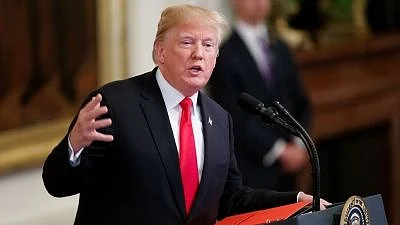On Thursday, 12 March, President Donald Trump boasted of “smooth” coronavirus testing across the country. The next day, he pronounced the testing system inadequate, and assailed the public-health bureaucracy, Barack Obama and Joe Biden for not fixing it before he became the president.
But nothing changed in that system over those two days — Thursday and Friday — except Trump's stated opinion of it.
Trump has been saying inaccurately for days that the public health system was up and ready to give access to diagnostic tests for COVID-19 for everyone who needed them. He said a week ago the “beautiful" tests were there for all in need.
That's not true. But after the government's top infection expert told lawmakers on Thursday that the testing system has been a failure, Trump's boasts about preparedness became even less tenable.
In tweets on Friday, 13 March, he switched to blaming the Centers for Disease Control and Prevention and the Obama administration, and seemed to hold them responsible for needless deaths in another pandemic. His account is inaccurate.
Trump tweeted, “For decades the @CDCgov looked at, and studied, its testing system, but did nothing about it. It would always be inadequate and slow for a large scale pandemic, but a pandemic would never happen, they hoped. President Obama made changes that only complicated things further... Their response to H1N1 Swine Flu was a full scale disaster, with thousands dying, and nothing meaningful done to fix the testing problem, until now. The changes have been made and testing will soon happen on a very large scale basis. All Red Tape has been cut, ready to go!”
THE FACTS:
His newfound disdain for the CDC's actions and his criticisms of Obama and Biden are based on a faulty description of what happened in the 2009 H1N1 pandemic, initially called “swine flu.”
Then, the CDC’s flu surveillance network actually sounded the alarm, spotting two children in California who were the first diagnosed cases of the new flu strain. About two weeks later, the US declared a public health emergency and CDC began releasing anti-flu drugs from the national stockpile to help hospitals get ready. Trump declared a state of emergency on Friday, seven weeks after the first US case of COVID-19 was announced.
Testing wasn't the primary concern then. The huge challenge was finding a vaccine.
The new flu popped up in April, too late to insert into vaccine already being brewed for that fall. Switching strains was scientifically doable but it took months to grow the new flu virus in eggs and extract it to make a second, separate vaccine that didn’t become available until November, when the new flu was waning.
That vaccine delay prompted the CDC and National Institutes of Health (NIH) to spur research into new ways to make flu vaccine faster, by skipping having to grow the virus in eggs. Today egg-based shots still are most common but there are some faster-to-produce competitors. And NIH is pursuing a universal flu vaccine that one day might cover all strains in one dose, but is still years away.
On the testing front, 2009 does offer a bit of caution. While CDC’s lab test didn’t have the types of problems it has had with COVID-19, the agency did warn that some “rapid” tests that doctors used varied in accuracy. So far there are no rapid tests for COVID-19.
As for thousands dying, it actually turned out that the new H1N1 strain was less deadly than average seasonal flu. But even that comparison is problematic, because regular flu years are deadliest for the elderly while H1N1 was riskiest for younger people.
Trump's accusation that Obama introduced further complications appears to refer to a false point he has made before.
Food and Drug Administration guidance drafted during the Obama administration called for tighter regulation of so-called laboratory-developed tests, a market traditionally not overseen by the agency. Trump says that step made it more difficult to come out with a coronavirus test. But that guidance never took effect. And if it had, it would not have applied to public health emergencies like the current one.
(Published in an arrangement with The Associated Press)
